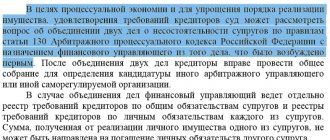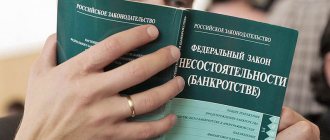Bankruptcy of a citizen (Russia)
- The debtor is prohibited from making gratuitous transactions;
- Purchase and sale of securities, vehicles, other property worth more than 50,000 rubles, transfer of property as collateral, participation in authorized capital - only with the written consent of the manager;
- Receiving or issuing loans (credits), providing guarantees, assigning claims - only with the written consent of the financial manager.
In addition, the restructuring process has the following consequences:
- the payment period for all existing monetary obligations is considered to have occurred;
- financial claims against the debtor must be presented to the court;
- accrual of all interest, fines, penalties and interest stops;
- enforcement proceedings are suspended.
About the consequences of bankruptcy proceedings
Legal consequences of financial insolvency of citizens (stipulated by Article 213.30 of the Federal Law):
- 5 years after being declared bankrupt (termination of proceedings), a person does not have the right to enter into loan agreements if he does not indicate the fact of his bankruptcy;
- 5 years after being declared bankrupt (termination of proceedings), a person does not have the right to file for re-bankruptcy. If a citizen is repeatedly declared bankrupt, and the applicant is a bankruptcy creditor or an authorized body, then during the course of the case the rule on releasing the citizen from obligations, prescribed in paragraph 3 of Article 213.28, does not apply. All claims of borrowers that have not been satisfied, but the enforcement period has come for them, are presented to the debtor in accordance with the legally established procedure. In a situation where the property has been sold, but there are unsatisfied demands of the borrowers (and the deadline for fulfilling them has arrived), the arbitration court issues a writ of execution to the interested parties.
- For 3 years, a bankrupt person does not have the right to take a position in the management bodies of a legal entity or participate in any way in the process of managing the legal entity.
- Insolvency (bankruptcy) can only be recognized on the basis of a decision of the arbitration court. “Not only an individual entrepreneur, but also any citizen who has taken a loan from a bank, purchased real estate or other expensive goods on credit, etc.,” may find himself in the position of a debtor with an unbearable burden of obligations.”
Signs of insolvency (bankruptcy) of individuals
Zagorovsky O. Modern legislation in many countries recognizes the need for a sign of a confluence of creditors.
Important
Thus, in France, one of the conditions for declaring a debtor insolvent is the presence of several creditors. If the debtor has one creditor, then bankruptcy proceedings are not opened, and forced collection is carried out within the framework of general civil proceedings in a lawsuit.
The current Bankruptcy Law does not contain such a requirement.
Restructuring instead of bankruptcy
Bankruptcy of a citizen is a procedure that is primarily designed to ease a person’s debt burden. And therefore, according to the legislator’s idea, one of the main mechanisms of interaction between creditor and debtor will be the restructuring of debt obligations. This opportunity is to determine the optimal repayment schedule for both parties.
The maximum duration of restructuring is 3 years. Moreover, the court will allow it only if the citizen has sources of income, and also if he is not convicted on economic charges. The restructuring plan, as prescribed by the bankruptcy law, is provided by creditors and approved by the court. A little later we will look at the specifics of its compilation.
While restructuring is underway, a citizen does not have the right to enter into transactions in an amount exceeding 50 thousand rubles without the consent of the manager. If a person violates this rule, then he will have, in accordance with the norms of the Code of Administrative Offenses of the Russian Federation, to pay a fine of 4-5 thousand rubles.
If a person has sufficient resources to timely comply with the terms of the restructuring, then the court will not touch his property. However, if the plan that we mentioned above is not provided, approved or executed, then the court has the right to initiate the sale of the debtor’s property. At this stage, restructuring actually turns into bankruptcy. But not all property can be used to pay off the debt. Property that is life-sustaining for a citizen and his family is not subject to seizure and sale.
Simultaneously with declaring a person bankrupt, the court may also impose a restriction on the debtor from traveling abroad. It will remain in effect until the person pays. He may also be prohibited for a certain time from taking and issuing loans, being a guarantor, or holding leadership positions.
Signs of insolvency (bankruptcy)
- What is declaring an individual bankrupt?
- An individual can be declared bankrupt only in court, after the bankruptcy procedure has been completed.
- What is a ruling on declaring a debtor bankrupt?
- The court declares a citizen bankrupt if it is impossible to apply debt restructuring or if the court-approved restructuring plan is not implemented. Once a citizen is declared bankrupt, a procedure for the sale of property is introduced.
- What are the grounds for declaring a debtor bankrupt?
- The basis for declaring a debtor bankrupt is the proven fact of the debtor's insolvency.
Law
of 2002 No. 127 establishes three situations for declaring the insolvency of a private person:
- bankruptcy of a person who does not specialize in individual entrepreneurship;
- insolvency procedure for an individual entrepreneur;
- bankruptcy of the peasant farm.
Signs of insolvency
The main sign of bankruptcy is the inability of a person to repay demands from creditors for financial obligations within 90 days from the day on which they must be fulfilled.
However, in order to introduce insolvency proceedings against an individual, three more grounds must be present:
- A period during which a person was unable to fulfill accepted duties.
- An indicator of the ratio of the size of obligations to the size of property owned by a person.
- Amount of debt.
In accordance with Article 3 of Federal Law No. 127, to begin the insolvency procedure, it is necessary to have a debt exceeding the amount of property owned by him.
Moreover, the arbitration court can open a bankruptcy case only if the total amount of all debt obligations of a person is at least 10 thousand rubles.
According to the above requirements, the principle of non-payment applies to a person who is not an individual entrepreneur.
Concept, criteria, signs of insolvency (bankruptcy)
V.T. BatychkoBusiness lawLecture notes. Taganrog: TTI SFU, 2011. Currently, relations related to insolvency are regulated by the following regulatory legal acts: 1.
Attention
Civil Code of the Russian Federation; 2. Arbitration Procedural Code of the Russian Federation of June 14, 2002 (as amended on July 27, 2010) (hereinafter referred to as the Arbitration Procedure Code of the Russian Federation); 3. Federal Law of February 25, 1999 No. 40-FZ “On the insolvency (bankruptcy) of credit organizations” (as amended.
07/19/2010);
4. Federal Law of September 27, 2002 No. 127-FZ “On Insolvency (Bankruptcy)” (as amended on December 28, 2010); 5. Resolution of the Plenum of the Supreme Arbitration Court of the Russian Federation dated December 15, 2004 No. 29 “On some issues of the practice of applying the Federal Law “On Insolvency (Bankruptcy)”, etc.
Is the law current?
Actually, why was the draft law on bankruptcy of citizens developed? According to some experts, this is due to the rather large accumulated volume of debts of Russians - to banks, tax authorities, as well as to housing and communal organizations. According to some data, the total amount of corresponding obligations of citizens now amounts to more than 600 billion rubles.
Based on an analysis of the situation with debts, a bill on bankruptcy of citizens was developed, which, first of all, describes the procedure for determining individuals who are not associated with business as insolvent. That is, in the previous version of the Federal Law, as lawyers note, there were no direct formulations regulating how Russians who are not in the status of individual entrepreneurs should be declared bankrupt.
There is information that amendments to the Federal Law on bankruptcy of citizens were supposed to come into force in 2020. But due to economic sanctions and a more complicated situation in the economic system of the state, as a result of which the debt of Russians may increase, the authorities decided to introduce the corresponding legal act earlier. Thus, it will come into force on July 1, 2020. According to experts, the corresponding legislative initiative is quite relevant. In addition, in world practice, such legal acts, as some lawyers note, have proven their usefulness.
Bankruptcy procedure for an individual.
- when the body of the debtor, authorized in accordance with the constituent documents of the debtor to make a decision on the liquidation of the debtor, made a decision to apply to the arbitration court with an application from the debtor;
- when the body authorized by the owner of the property of the debtor - a unitary enterprise, made a decision to apply to the arbitration court with an application from the debtor;
- if during the liquidation of a legal entity it is established that it is impossible to satisfy the claims of creditors in full;
- in other cases provided for by this Federal Law.
It should be noted that the application in these cases is submitted by the debtor regardless of whether his property is sufficient to cover legal costs or not. H.
Signs of bankruptcy of a citizen and legal entity
The main sign of bankruptcy is insolvency. The concept and signs of insolvency (bankruptcy) are the first thing you should pay attention to if you suspect that a citizen is bankrupt. So, what is insolvency from a legislative point of view? The insolvency or insolvency of a citizen is understood as his inability to fully satisfy the demands of creditors (or other persons and organizations) for monetary payments and (or) fulfillment of obligations to pay other obligatory payments. If otherwise is not proven, then the individual is presumed to be insolvent.
But only if at least one of the following circumstances is present:
- The person stopped making payments to the bank. That is, it ceased to fulfill its obligations to pay funds to the bank within the prescribed period.
Topic 7. concept and signs of bankruptcy
Info
If there are sufficient grounds to believe that, taking into account the planned receipts of funds, including income from the activities of a citizen and the repayment of debt to him, the citizen will be able to fulfill in full his monetary obligations and (or) the obligation to pay mandatory payments within a short period of time, the deadline the fulfillment of which has occurred, the citizen cannot be declared insolvent. 4. The ruling of the arbitration court on recognizing as justified an application for declaring a citizen bankrupt and introducing the restructuring of his debts must contain indications of: the date of the court hearing to consider the citizen’s bankruptcy case; approval of the financial manager (last name, first name, patronymic of the arbitration manager, name and address of the self-regulatory organization from among whose members the financial manager was approved).
Extrajudicial bankruptcy of a citizen: instructions for use
On July 31, 2020, the Federal Law of July 31, 2020 No. 289-FZ “On Amendments to the Federal Law “On Insolvency (Bankruptcy)” and certain legislative acts of the Russian Federation regarding extrajudicial bankruptcy of a citizen” was published, which comes into force on September 1, 2020 .
Initiation and duration the extrajudicial bankruptcy procedure for a citizen .
✅There are two conditions for initiating extrajudicial bankruptcy proceedings for a citizen (in total):
- the total amount of monetary obligations and obligations to make mandatory payments on the principal debt (including obligations that have not yet matured and obligations to pay alimony) is not less than fifty thousand rubles and not more than five hundred thousand rubles;
- the end of enforcement proceedings in connection with the return of the writ of execution to the claimant due to the debtor’s lack of property on which foreclosure can be applied (regardless of the volume and composition of the claims of the claimant), as well as the absence of other enforcement proceedings initiated after the return of the writ of execution to the claimant.
Compliance with such conditions is assumed.
✅The procedure for extrajudicial bankruptcy of a citizen can be initiated only upon the application of the citizen himself. The bankruptcy creditor and the authorized body are not entitled to file an application to declare a citizen bankrupt out of court.
✅Both a citizen (individual) and an individual entrepreneur can be declared bankrupt out of court.
✅A citizen’s obligations under a surety agreement are taken into account regardless of the delay of the main debtor.
✅To be applied for non-fulfillment or improper fulfillment of an obligation are penalties (fines, penalties), interest for late payment, damages in the form of lost profits, subject to compensation for non-fulfillment or improper fulfillment of an obligation, as well as other property and (or) financial sanctions, including for failure to fulfill the obligation to pay mandatory payments are not taken into account when determining the emergence of a citizen’s right to apply for bankruptcy out of court.
✅The procedure for extrajudicial bankruptcy of a citizen for a period of six months is carried out through a multifunctional center for the provision of state and municipal services (hereinafter referred to as the MFC) at the citizen’s place of residence or place of stay by including the relevant information in the Unified Federal Register of Bankruptcy Information (hereinafter referred to as the EFRSB).
When contacting the MFC, a citizen must fill out an application for declaring the citizen bankrupt out of court in the form approved by Order of the Ministry of Economic Development of the Russian Federation dated 04.08.2020 No. 497, and a list of creditors in the form approved by Order of the Ministry of Economic Development of Russia dated 05.08.2015 No. 530.
The application for declaring a citizen bankrupt out of court also indicates information known to the citizen about the credit institutions with which he has entered into a bank account (deposit) agreement.
✅Consideration of an application to declare a citizen bankrupt out of court at the MFC and inclusion of information in the EFRSB is carried out without charging a fee.
✅One working day has been established for the MFC to consider a citizen’s application to declare him bankrupt out of court and three working days to include information about the initiation of a citizen’s extrajudicial bankruptcy procedure in the EFRSB or to return the application.
The MFC checks the availability of information about the return of the writ of execution to the claimant, as well as the absence of information about the conduct of other enforcement proceedings initiated after the date of return of the writ of execution to the claimant and not completed or terminated at the time of checking the information, using publicly available information from the data bank in enforcement proceedings posted on website of the Federal Bailiff Service on the Internet information and telecommunications network.
✅The citizen’s application is subject to return if the data bank on enforcement proceedings does not contain information about the return of the executive document to the claimant or there is unfinished or unterminated enforcement proceedings. Repeated application to the MFC is possible in a month. The return of the application can be appealed to the arbitration court at the citizen’s place of residence.
✅The EFRS contains identifying information about a citizen, his creditors and the amount of their claims.
✅The MFC sends a copy of the notification about the inclusion in the EFRSB of information about the initiation of an extrajudicial bankruptcy procedure: to credit organizations with which the citizen has a bank account (deposit) agreement, to a court of general jurisdiction, to the bailiff service at the citizen’s place of residence, an authorized body, and also to the body that registered the citizen as an individual entrepreneur.
Consequences of initiating extrajudicial bankruptcy proceedings for a citizen .
✅ From the date of inclusion in the EFRSB of information about the initiation of a citizen’s extrajudicial bankruptcy procedure, the following consequences occur:
1. a moratorium is introduced on satisfying the claims of creditors specified in the application for declaring a citizen bankrupt out of court (with the exception of claims for compensation for harm caused to life or health, in cases of reclaiming property from someone else’s illegal possession, on eliminating obstacles to the ownership of said property, on recognition of ownership of the specified property, on payment of wages and severance pay, on compensation for moral damage, on the collection of alimony, as well as other claims inextricably linked with the identity of the creditor, including claims not stated when filing an application for declaring a citizen bankrupt out of court (hereinafter referred to as claims to which the moratorium does not apply).
If the bailiff service receives an executive document on the requirements specified in the application for declaring a citizen bankrupt out of court, a decision is made to refuse to initiate enforcement proceedings.
2. the deadline for fulfilling the citizen’s obligations that arose before the date of inclusion in the EFRSB of information on the initiation of the citizen’s extrajudicial bankruptcy procedure is considered to have occurred (with the exception of claims to which the moratorium does not apply);
3. the accrual of penalties (fines, penalties) and other financial sanctions, as well as interest on all obligations of a citizen (except for claims to which the moratorium does not apply) ceases;
4. enforcement documents cannot be sent to a bank or other credit organization directly by the claimant and must be presented only to the bailiff service;
5. execution of executive documents on property penalties from a citizen is suspended (with the exception of executive documents on claims to which the moratorium does not apply).
The basis for suspending the execution of executive documents is the inclusion of information about the initiation of extrajudicial bankruptcy proceedings in the EFRSB.
6. The bailiff removes arrests from the citizen’s property imposed in order to ensure the execution of executive documents on the requirements specified in the application for declaring him bankrupt out of court. New arrests on the property of a debtor-citizen and other restrictions on the disposal of this property can be imposed only in order to ensure the execution of executive documents on claims not specified by the debtor-citizen in the application for declaring him bankrupt out of court, as well as on claims for which there is no moratorium distributed by;
7. a ban is established on transactions for obtaining loans, credits, issuing guarantees and other security transactions.
✅During the procedure for extrajudicial bankruptcy of a citizen, creditors indicated in the list of creditors have the right to request information about the citizen’s property from the registering authorities through the system of interdepartmental electronic interaction in the manner approved by the Government of the Russian Federation.
From the date of inclusion in the EFRSB of information about the initiation of an extrajudicial bankruptcy procedure for a citizen, the consent of the debtor citizen to provide the information available to creditors to the bodies carrying out state registration or other accounting (registration) is considered provided.
Termination of the procedure for extrajudicial bankruptcy of a citizen .
✅If, during the extrajudicial bankruptcy procedure, a citizen receives property into the citizen’s ownership (as a result of challenging a transaction, accepting an inheritance, or receiving it as a gift) or other significant change in the citizen’s property status, the citizen’s extrajudicial bankruptcy procedure is terminated.
The citizen is obliged to notify the MFC about this within five working days. If a citizen fails to fulfill this obligation, the creditor indicated in the list of creditors has the right to apply to the arbitration court to declare such a citizen bankrupt.
No later than three working days from the date of receipt of the citizen’s notification, the MFC includes in the EFRSB information about the termination of the citizen’s extrajudicial bankruptcy procedure.
✅A citizen against whom an extrajudicial bankruptcy procedure has been initiated may be declared bankrupt in an arbitration court upon the application of a creditor not listed in the list of creditors.
✅A citizen against whom an extrajudicial bankruptcy procedure has been initiated may be declared bankrupt in an arbitration court upon the application of a creditor listed in the list of creditors in any of the following cases:
- indication of the debt owed to him not in full, which significantly affects the recognition of the citizen as bankrupt out of court;
- discovery of property or property rights belonging to the debtor that are subject to state registration or other accounting (registration);
— the presence of a court decision that has entered into legal force on a claim filed by such a creditor to declare the debtor’s transaction invalid;
— failure by a citizen to fulfill the obligation to notify the MFC of a significant change in his property status.
✅The procedure for extrajudicial bankruptcy of a citizen ends from the day the arbitration court introduces the procedure for restructuring the citizen’s debts.
The arbitration court, within three working days, sends a copy of the ruling on the introduction of a procedure for restructuring the citizen’s debts to the MFC, which, within three working days, enters into the EFRSB information about the termination of the citizen’s extrajudicial bankruptcy procedure.
✅The MFC sends a copy of the notice of termination of the citizen’s extrajudicial bankruptcy procedure to the authority that registered the citizen as an individual entrepreneur.
Completion of extrajudicial bankruptcy procedure for a citizen .
✅After six months from the date of inclusion of information about the initiation of an extrajudicial bankruptcy procedure for a citizen in the EFRSB, the procedure is completed and the citizen is released from further fulfillment of the claims of the creditors indicated by him in the application for declaring him bankrupt out of court, taking into account the total amount of monetary obligations and payment obligations mandatory payments.
The debt of a citizen to the creditors indicated by him in the application for declaring him bankrupt out of court is recognized as a bad debt.
✅A citizen for whom the extrajudicial bankruptcy procedure has been completed is not released from the following obligations:
- not specified in the application for declaring a citizen bankrupt out of court;
- for compensation for harm caused to life or health, for compensation for moral damage, for the collection of alimony, as well as other claims inextricably linked with the personality of the creditor;
- if, by a judicial act that has entered into legal force, a citizen is brought to criminal or administrative liability for unlawful actions in bankruptcy, intentional or fictitious bankruptcy, provided that such offenses were committed in this procedure for the citizen’s extrajudicial bankruptcy;
- if it is proven that when the obligation arose or was fulfilled on which the claim in the extrajudicial bankruptcy procedure of a citizen is based, the citizen acted illegally, including committing fraud, maliciously evaded repayment of accounts payable, evaded paying taxes and (or) fees from an individual, provided the lender with knowingly false information when receiving a loan, concealed or deliberately destroyed property (hereinafter referred to as obligations from which the citizen is not exempt).
✅On the day of completion of the extrajudicial bankruptcy procedure for a citizen, the MFC is obliged to include in the EFRSB information about the completion of such a procedure.
✅ From the moment information on the completion of the extrajudicial bankruptcy procedure of a citizen is included in the EFRSB, the bailiff completes the enforcement proceedings according to the requirements specified in the application for declaring the citizen bankrupt out of court, with the exception of executive documents on requirements from which the citizen is not exempt.
✅If a citizen’s application for declaring him bankrupt out of court indicates the amount of the creditor’s claims, which is less than the actual amount of the creditor’s claims, the citizen is released from obligations to this creditor in the amount specified in the application. If such a statement indicates the amount of the creditor's claims, which is greater than the actual amount of the creditor's claims, the citizen is released from obligations to this creditor in the amount of the actual amount of his debt.
✅When completing the extrajudicial bankruptcy procedure in relation to a citizen excluded from the unified state register of individual entrepreneurs less than one year before filing an application to declare the citizen bankrupt out of court, the following consequences of declaring an individual entrepreneur bankrupt apply:
- a citizen cannot be registered as an individual entrepreneur, as well as carry out entrepreneurial activities and hold positions in the management bodies of a legal entity (except for a credit organization), or otherwise participate in the management of a legal entity (except for a credit organization) for five years from the date of completion of the procedure for extrajudicial bankruptcy of a citizen;
— a citizen has no right to hold positions in the management bodies of a credit organization or otherwise participate in the management of a credit organization for ten years from the date of completion of the citizen’s extrajudicial bankruptcy procedure.
✅The MFC sends a copy of the notice of completion of the citizen’s extrajudicial bankruptcy procedure to the authority that registered the citizen as an individual entrepreneur.
Consequences of completing the procedure for extrajudicial bankruptcy of a citizen .
✅In case of completion of the extrajudicial bankruptcy procedure of a citizen, the following consequences apply:
- a citizen does not have the right to assume obligations under credit agreements and (or) loan agreements without indicating the fact of his bankruptcy within five years from the date of completion of the citizen’s extrajudicial bankruptcy procedure;
— a citizen has no right to hold positions in the management bodies of a legal entity or otherwise participate in the management of a legal entity for three years from the date of completion of the citizen’s extrajudicial bankruptcy procedure;
— a citizen has no right to hold positions in the management bodies of a credit organization or otherwise participate in the management of a credit organization for ten years from the date of completion of the citizen’s extrajudicial bankruptcy procedure;
- a citizen does not have the right to hold positions in the management bodies of an insurance organization, non-state pension fund, management company of an investment fund, mutual investment fund and non-state pension fund or microfinance company, or otherwise participate in the management of such organizations for five years from the date of completion of the citizen’s extrajudicial bankruptcy procedure .
✅A citizen has the right to file an application for declaring him bankrupt out of court again no earlier than ten years after the date of completion of the extrajudicial bankruptcy procedure or the day of its termination.
conclusions.
The institution of extrajudicial bankruptcy of a citizen, new to Russian bankruptcy law, so far raises more questions than it provides answers, and requires the prompt adoption by the Supreme Court of the Russian Federation of the corresponding resolution of the Plenum in order to prevent arbitration courts from independently interpreting the new provisions of paragraph 5 of Chapter X of the Bankruptcy Law and eliminating gaps in it ( for example, in relation to the bankruptcy of spouses and the bankruptcy of the estate).
A large discussion of this institute took place on August 6, 2020 at the Civil Club of the Russian School of Private Welfare Magazine together with the Bankruptcy Club, moderated by Andrey Egorov, and speakers by Oleg Zaitsev, Rustem Miftakhutdinov, Daniil Savchenko, Alexey Yukhnin and Andrey Smirnykh.
As a result of this event, its participants raised no less than fifty complex questions related to the implementation of a new procedure for extrajudicial bankruptcy of a citizen.
For example, the law establishes a rule on the non-release of a citizen, for whom the extrajudicial bankruptcy procedure has been completed, from obligations in cases of his committing unlawful actions during bankruptcy or malicious evasion of repayment of accounts payable (paragraph one of paragraph 2 of Article 223.6 of the Bankruptcy Law). The question arises: who, at what moment and how has the right to establish facts of dishonest behavior of a citizen?
The speakers came to the conclusion that resolving these issues is not within the competence of the MFC and suggested that creditors of such an unscrupulous citizen file a conversion claim with the arbitration court against the citizen for not releasing him from his obligations (a property claim that is paid by the state duty and can be filed as in during the extrajudicial bankruptcy procedure of a citizen, and after its completion within the general three-year limitation period) or, in accordance with Chapter 24 of the Arbitration Procedure Code of the Russian Federation, appeal the actions of the MFC to include information about the initiation of an extrajudicial bankruptcy procedure for a citizen in the EFRSB.
The law also provides for a limited list of cases in which a creditor listed in the list of creditors has the right to apply to an arbitration court to declare a citizen bankrupt after initiating extrajudicial bankruptcy proceedings (subparagraph 2 of paragraph 2 of Article 223.5 of the Bankruptcy Law).
At the same time, the question remains open, what should such a creditor do if facts of concealment by a citizen of property or illegal transfer of property by a citizen to third parties are revealed, in addition to such a creditor filing a claim to invalidate the debtor’s transaction?
The participants in the above discussion suggested that the creditor, in this case, apply to the arbitration court with an application to terminate the extrajudicial bankruptcy procedure for a citizen and initiate a bankruptcy case, or to challenge the bailiff’s decision to terminate enforcement proceedings in connection with the return of the writ of execution to the recoverer due to the debtor’s lack of property, which may be subject to foreclosure.
In addition, the speakers recalled that the law does not prevent a creditor from collecting debt from a citizen in court and during the procedure of his extrajudicial bankruptcy.
These and other complex issues of the practice of applying the new provisions of the law on extrajudicial bankruptcy of a citizen can be found by watching the recording of this “star” event on the website of the Russian ShchP magazine.
My expert commentary on the shortcomings in the Federal Law of July 31, 2020 No. 289-FZ on extrajudicial bankruptcy of citizens and what problems creditors, as well as debtor citizens, may face in such bankruptcy can be found in the latest issue of the EZh-Lawyer newspaper » No. 32 (1133) 2020.










